#I just thought a visual example would be helpful to get this point across
Note
hiii rix. actually i am curious about like how you go about coming up with/referencing dynamic poses (especially for full body) -- you are so good at getting across a lot of action & character in static images & i'm curious if there's anything you do to maintain that energy and what the thought process is to express things abt a character visually. if that makes sense
YEAH THAT MAKES SENSE- I don't use references much so most poses come from just playing around with sketches but it's encouraged to have expressive poses while still referencing real photos/figures
To make things more dynamic a good thing to keep in mind is the shape of the line of action. I personally learned that you push for "S and C shapes" and avoid "I and W shapes", which basically boils down to avoiding lines of action that have no movement or that have more than 2 directional changes

Personally I don't find much wrong with an "I" pose but using them does mean it'll feel less dynamic, finding places to add slight curves that follow S/Cs adds more weight and movement is still important in more subtle poses. But W poses fucking suck, they get way too complicated and make it so the eye can't follow as easily
Oh also more importantly it's good to get across the actual personality and energy of the character in the pose. If the pose reads as dynamic and expressive but isn't something the character would do then what's even the point- A good bit of characterization to spice up the poses adds a lot to the overall drawing. Some examples could be making the character stumble a bit in their movement or give a character sharper lines of action to show theyre stiffer/more focused or give a lazier character lines of action that are more flowy/pulled down. All of this can be played around with to make a character stand out more and give audience's a faster read on their mood or personality
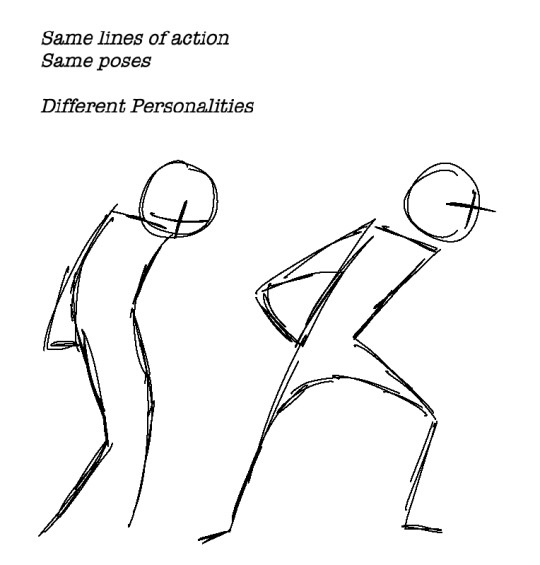
If you wanna practice this I'd personally try short paced figure drawing, where you draw a pose and only have like 15 seconds to finish it before moving on to the next one- But rather than drawing the figure accurately try and draw the pose pushed to an extreme. This trains your brain to see the line of action and simplify the form as much as possible, plus it helps you get faster at drawing
85 notes
·
View notes
Note
holds out cup
a bit of your thoughts on character designing? your characters are all so distinct and unique, I've been wanting to ask for awhile how you went about your sillies!
You fool. You idiot. You absolute buffoon. You have no idea what you've done. You have no idea what I am about to unleash unto you all.
Hi i am extremely autistic about character design so obligatory [read more] because I am gonna fucking TALK your EAR OFF about this shit, prepare for a fuckass LOOOOOOOOONG post
So the first rule of character design is to fuck around and have fun :)
Anyway onto the real shit:
P1: Foundational Shit
For starters, I'll link you to a post I made like 3 years ago on this topic, just to get some foundational shit out of the way!
Me personally, I have a very rigid structure I stick to whenever I design characters, which is:
I must know what their personality is like
I must know what their fashion tastes are
I must know what their role in the story is (this one only applies if the character is even apart of a bigger narrative in the first place, obviously. I just am strict and don't make new characters unless I have a purpose for them to serve in my stories so it's hard baked into how I operate as a character designer lol)
By having these in mind when I design characters, shit becomes a WHOLE lot easier/more natural for me. This is because:
The personality of a character can usually be reflected in their design, whether it be a bubbly loud energetic guy who's dolled up in bright colors and playful clothing accessories, a commanding bossy stoic guy who's dolled up in subtle and professional clothing pieces, or even subverting this idea by having a character who acts one way but dresses in a way you'd expect from the opposite.
Knowing what kinds of fashion this character would be into in the first place makes it a whole lot easier to get ideas and look for resources on ways you can style them- Knowing the character would be interested in like, for example, scene fashion makes it far easier to look for the type of clothing they'd wear and find pieces that stand out to you so you can start experimenting with what works or what doesn't for that character.
Knowing the role they play can also help a lot when designing them, much like knowing their fashion tastes can. However, where knowing their fashion tastes helps in looking for visual inspiration, knowing their role in a story can help with their design in a thematic sense; If the character is supposed to be some kind of trouble maker rebellious kid, then you're probably going to wanna make them visually fit the bill (or, again, you might want to subvert the idea of what a rebellious little shithead looks like so you go for the opposite of what people imagine!) Ykwim?
Now with that out of the way, let's get some VISUAL EXAMPLES, using my guys obviously lmao
For an example of the personality thing, here's a page I made where I talk about my thought process behind the designs of some of my goons in regards to taking into account their personality (and aesthetic taste):

For an example of the story role thing, here's a page I made where I talk about my thought process behind the designs of Eb and Ben (+Neco and Alli) in regards to the role they play in their story:
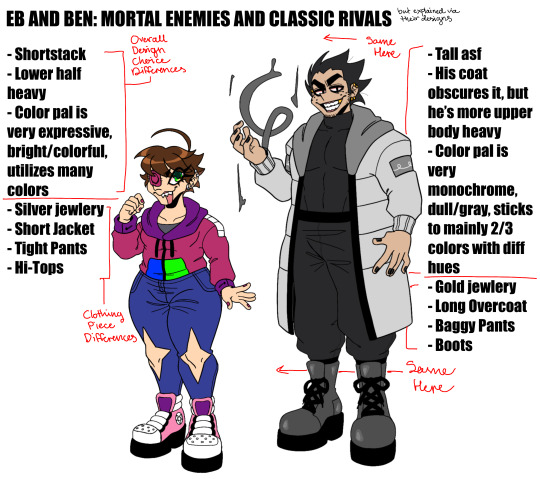
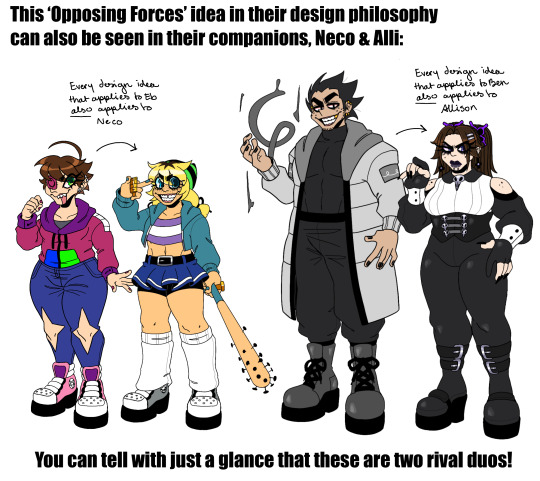
I hope this gets the point across!
P2: Additional Stuff to Consider
In addition to the above section, there's also some other things you can utilize to try and make your designs stand out!
One such thing is brainstorming ideas for stand out design elements! Like, something that' makes them stand out from the crowd, or an element of their design that is so specific to them that they just can't be the same character without it. This thing in general is kind of vague by nature so here's some examples using my guys that I think get the point across:

You can also go the extra mile and give them little design details that just add that little extra bit of "oomf" to the character overall. Again, this is kind of vague by nature, but here are some examples I can give with my characters. Some of these doodles are OLD AS HELL so that's why the art style is outdated, but the point still stands!
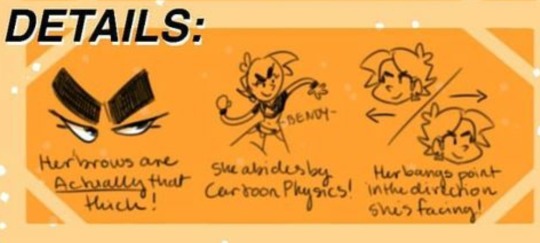

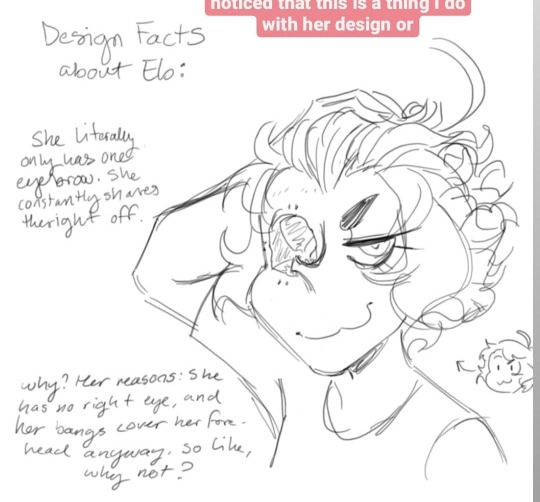
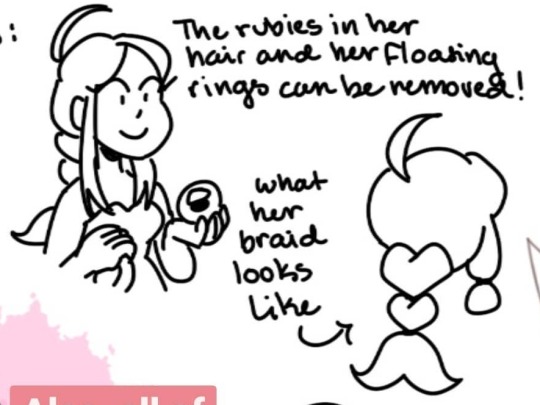
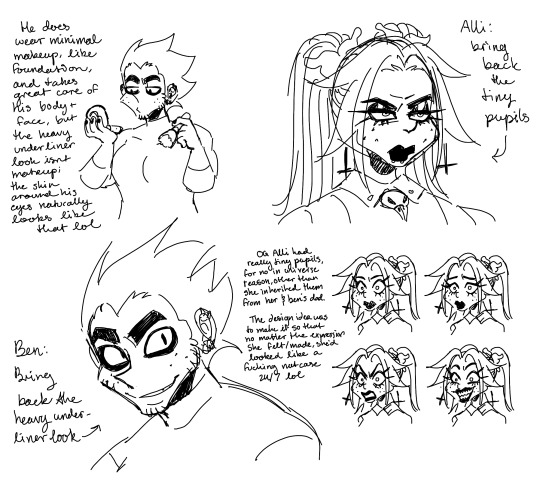
You can also go the extra mile to try and diversify your designs by doing some structural tests with your characters. What I mean by this is by literally dumbing them down to their most basic attributes, or as I like to call it, "Run the Silhouette & Recognition Test" What I mean by this:
The Silhouette Test: Making a lineup of your characters and blacking them out so they show up as silhouettes, which allows you to check the readability and/or recognizability of your character's design, and if it's unique from your other characters!
Recognition Test: Make a lineup of all of your character's heads and/or bodies, and only draw their facial features/head shape and/or body shape/structure, nothing else. I do this mainly to help myself try to avoid face/body syndrome and I think it works pretty well for me!


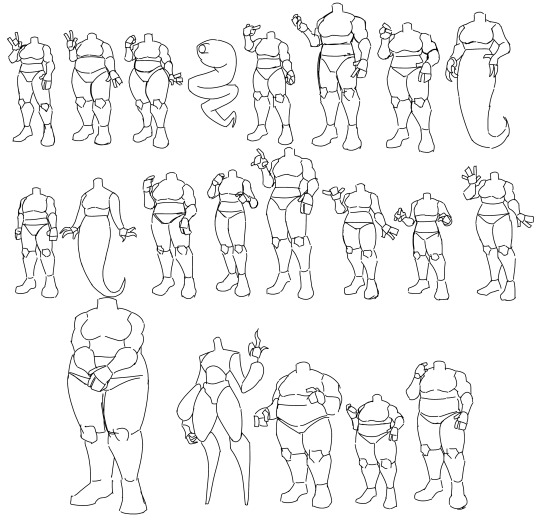
Now, for my last extra thing; Remember my point about knowing a character's taste in fashion? This is applies here. Knowing your character's fashion tastes can make designing their main outfit, or any other alternate outfits you make for them, like SUPER fuckin easy. Here's a couple examples with some of my gals:

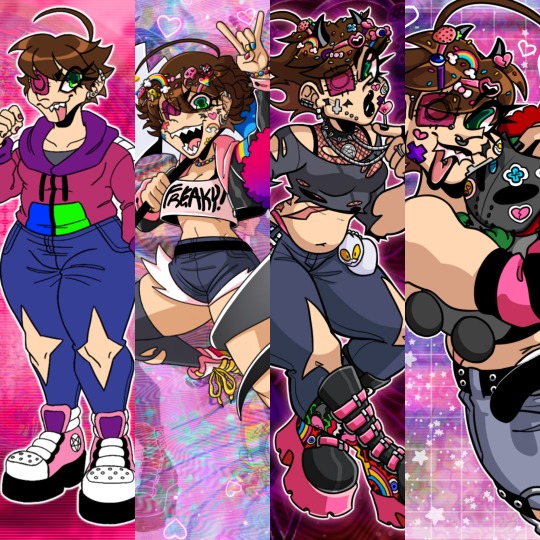

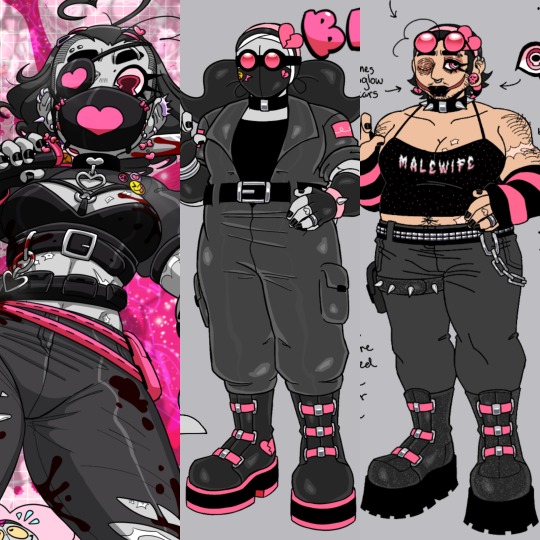
Raina likes real casual clothes, simple shit like crop tops/tank tops n' jeans, just styled to her liking. She's a simple chick with simple tastes! But there are noticeable touches, like how she has a habit of changing her earrings to match the occasion she's celebrating!
Eb likes grungy clothes, and adds flair to her outfits by dipping into a decora kei inspired style of accessorizing, which compliments her nicely since she loves customizing things to make them her own. She's not fully there with the extravagance of it yet but she's getting there!
Yume likes pastel colors and form fitting clothes, sometimes with loose jackets/robes to keep her cozy, with minimal accessories. She's also simple, but unlike Raina, she doesn't tend to try and go the extra mile with jewelry and/or makeup, not often.
Bank's a baby punk and is still finding her style, but it's clear she likes a lot of leather, spikes, chains, all that kind of shit. Dark colors, with minimal touches of her favorite color (pink lol), and some accessories like earrings, pins, and/or straps are enough to complete a look for her. And of course, any clothing article to obscure her face works for her!
I hope I don't sound fucking nuts I genuinely put way too much time into thinking about all of this stupid bullshit lmao
P3: Actual Examples of Me Working Through the Character Design Process
I figure if I show off examples where I was working on concept shit, that'd help put this into something digestible for y'all lol.
For starters, here's a doodle page I made back in 2021 when I was making small tweaks to a couple of my guys designs, which is why my art style looks old and some characters have their outdated looks lol:
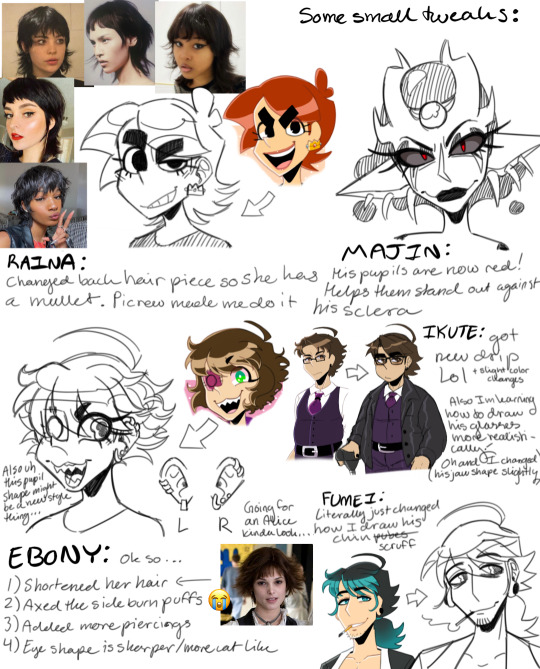
Now, here's a MUCH more recent example of my concept process, where I was figuring out the idea for Namgi's new design (which is still being worked on atm lol):
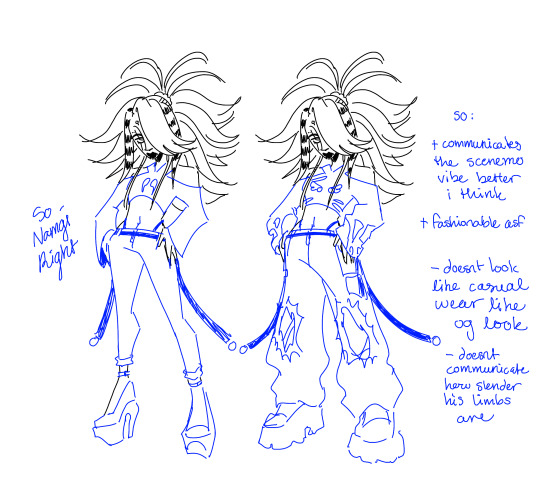

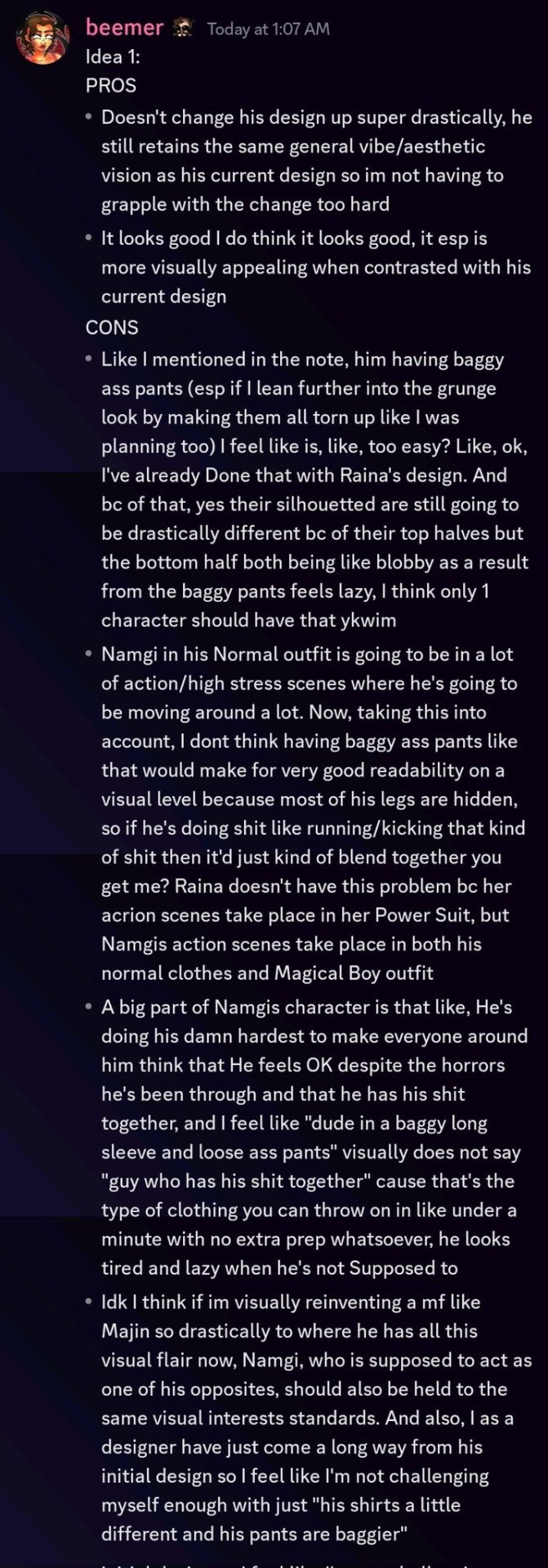

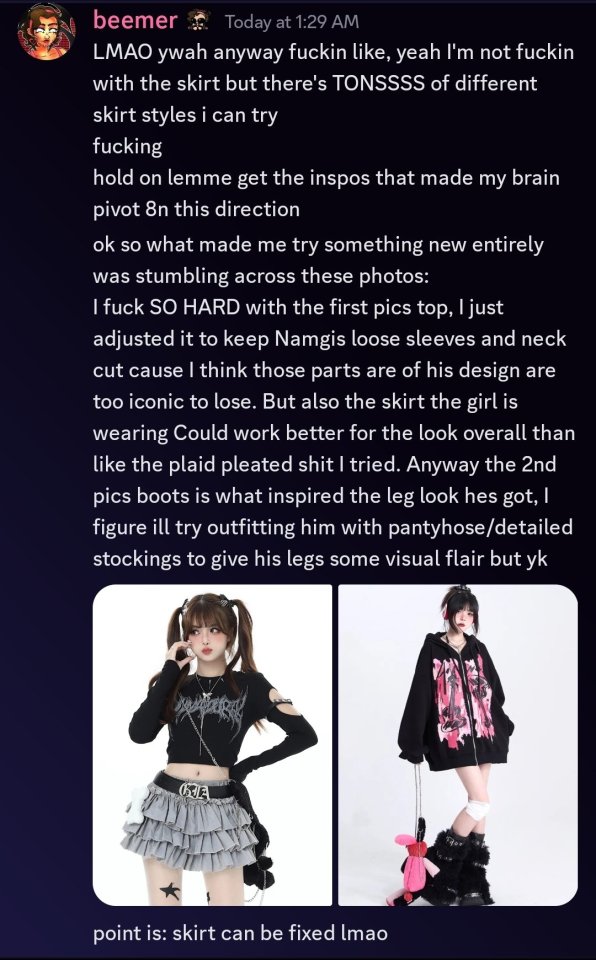
Here's the concept pages I made when I was figuring out Majin's recent redesign:
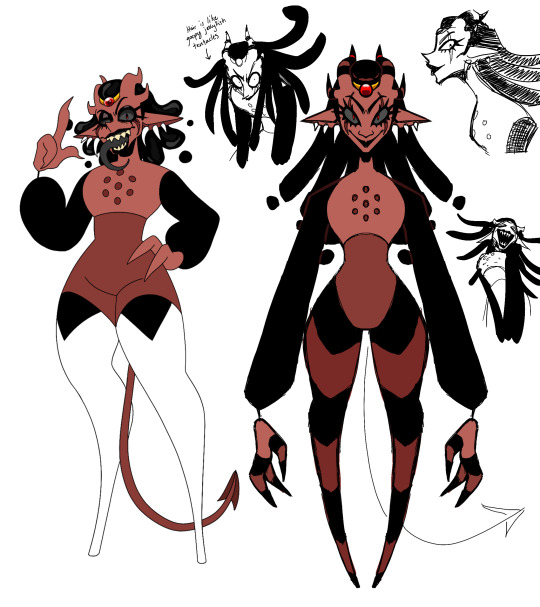
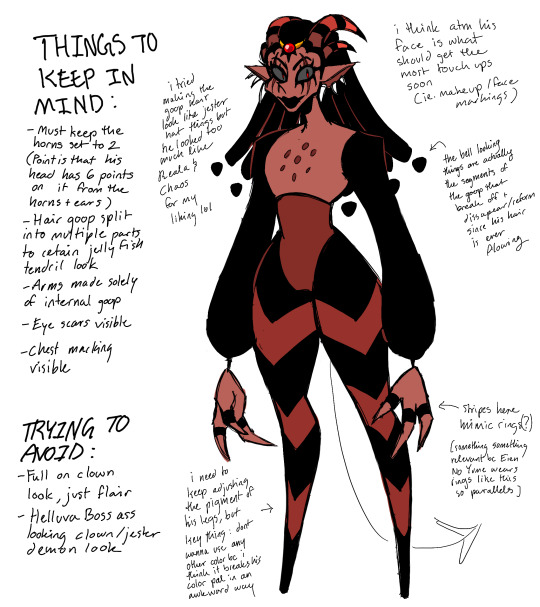
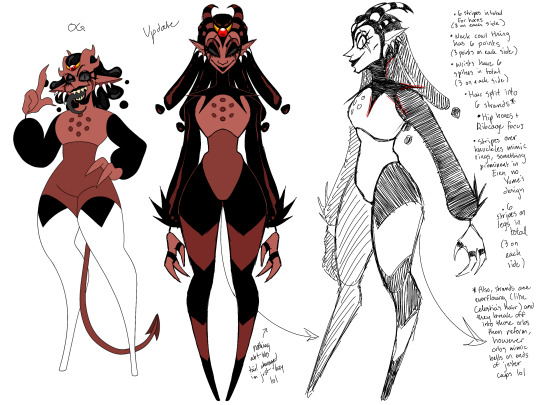
And here's some concept pages I made when I I was figuring out the Possessed Form designs for my hosts!
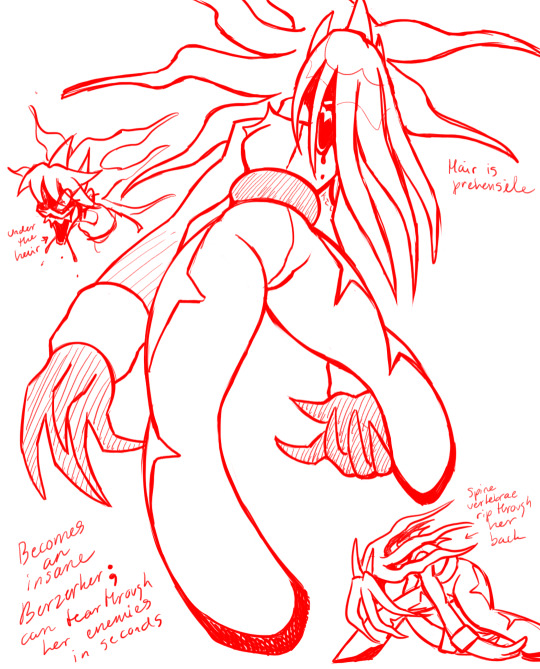
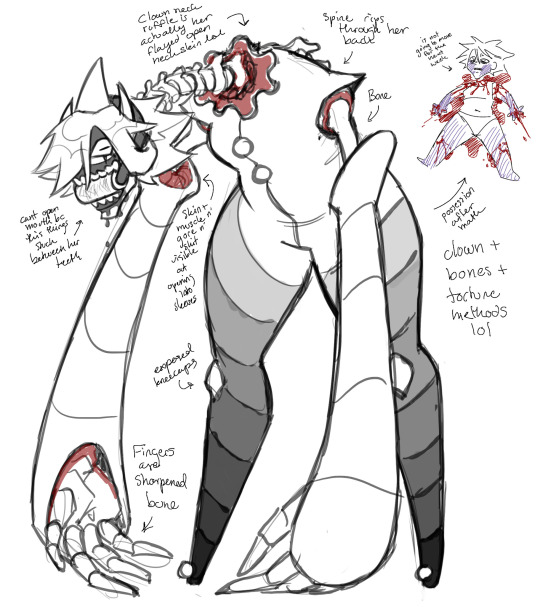

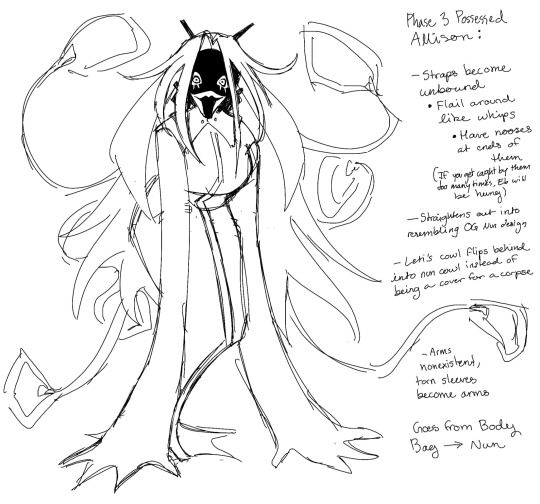

I hope this is all actually helpful and not just like. stupid nothing shit lmao
And like, yanno, you don't HAVE to do/listen to any of this, this is just the kind of shit I've learned over the years that personally helps me with coming up with designs that feel fresh and distinct, at least for my personal tastes! Something I do might just not work for you, the design process is unique for everyone obviously. It's the same thing as your art style, everyone does shit differently lol
This concludes my Autism Ramble!!
73 notes
·
View notes
Note
Got any good resources for clothing drawing tips?
Okay so quick little introduction before I try to answer this question. First of all, sorry for letting this languish in the inbox for so long. I have a lot I want to say about this and I'd really like to make a proper "tutorial" but this week took a lot out of me so what you're going to get are some visual notes on graph paper and some rambling thoughts. Maybe down the line I'll try to flesh this out more into a proper guide, but for now it is what it is.
Second- for many different art concepts I can give you some really great recommended reading for self-teaching. There's a whole section of my website with links to things that helped me learn. Clothing is one of those things where I never found a book or tutorial that really "clicked" with me. It's one of the few areas of art where I feel like it's fair to say I'm genuinely self-taught. So what you're going to get here is very much my opinion, not undisputed common wisdom or whatever. Take it with a grain of salt. This is how I draw, not the "right way" to draw.
Third- drawing clothes is not something fundamental like perspective or rendering where there are actual hard-and-fast "rules" you can learn to guide you. It's not even like anatomy where there are approaches that have been worked out and passed down by artists over generations. I think about drawing clothing as a synthesis of several different skills- a little bit of anatomy, a little bit of perspective, a little bit of rendering. Honestly a smidge of graphic design. You're employing a "cloud" of your artistic skills towards a specific end. What this means is that the TLDR of this post is going to be "do what you would normally do to improve at drawing but apply it to clothing." So don't expect something life-changing, instead just open your mind to maybe trying some new things you hadn't thought of before. Also this is going to be more about drawing than painting, that is more about "lines" than "shapes" but the two skills overlap and the same concepts should be broadly applicable. But my examples are going to be drawings.
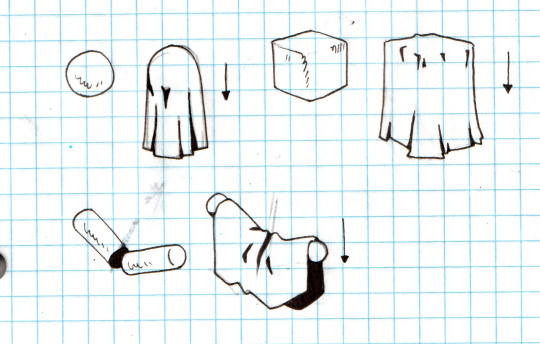
Okay intro out of the way. Clothes are mostly just tubes of fabric, fabric wants to fall down. The human body and sometimes wind and water and other fluids will stop this fabric from falling down all at once and instead give it a shape. Keep this in mind. It's helpful to know how clothes are actually constructed if you want to know how they will deform when falling across the figure. Where a garment is simply a length of fabric, it's very flexible. It can bunch together or be stretched taught. This is most noticeable at the parts of the body that open and shut like hinges- knees, elbows, and armpits. The behavior of garments at these areas of the body is highly dynamic.
At seams where different sections of fabric are stitched together, movement can be come more limited. Seams are usually imperfect- pieces of fabric of slightly different lengths might be stitched together or fabric may shrink over time around a thread causing it to pucker and wrinkle. For these reasons, seams often act as the originating areas for folds and wrinkles, even when a garment is not in a particularly flexed/active state.
In a two-dimensional image, it can be helpful to describe a garment in terms of silhouette and wrinkles/folds. The silhouette is the actual boundary of the garment, where the fabric comes to an end. The wrinkles/folds are where different parts of the garment pass in front of each other or where the fabric becomes bunched up to the point that light can't reach inside and occlusion shadows form. You should always keep the overall silhouette of the garment in mind to inform the bigger shapes you draw, but you will use wrinkles and folds to demonstrate how the garment twists and deforms. These are the basic tools in your arsenal. Keep it simple.
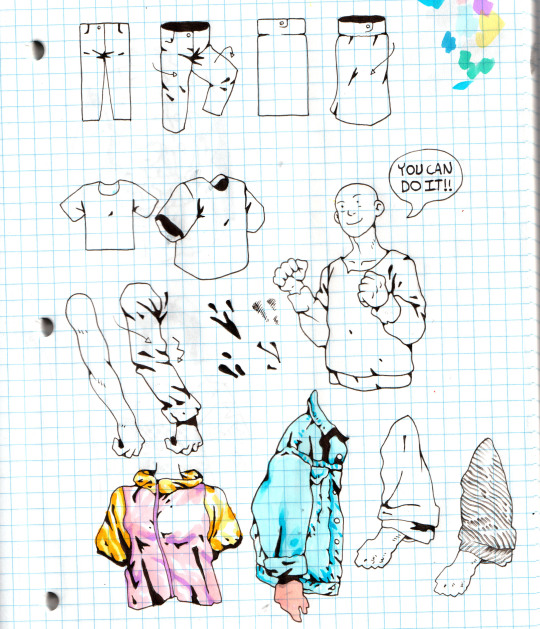
There are lots of different ways to approach wrinkles. My advice and my personal preference is to draw wrinkles as shapes and not just lines. Specifically, tapered shapes (like triangles) and be really good both for implying motion and the varying depth of a fold/wrinkle. Experiment with different shapes of varying angularity, fill texture, etc. Your hands and eyes will guide you towards what looks and feels good. There's no right way but I would advise you to exaggerate! Ask yourself- what's the biggest shape I can draw here? How can I twist it to make it bigger, crazier but still describe the form in a way that makes sense? It can be exhausting to just try to perfectly copy a reference and also using your imagination like this when doing studies will help build up your visual library for when you're drawing/designing clothing from imagination. In general I would advise you to focus more on drawing something that looks good (ie is composed of shapes that you find aesthetically pleasant) than is "correct."
Quick recap: Garments fall down, you can simplify an article of clothing into a silhouette described by folds and wrinkles. What next? Observe! Take notes! It is worth your time to think about how common articles of clothing are constructed. Jeans, t-shirts, dresses, etc. I used to do some hobbyist sewing and clothing alteration and I think that hands-on work with clothes has really affected the way I think about drawing them. You don't have to go that far but like- look at the world around you. Stuck on the bus, in school, in a meeting, etc? Even if you can't draw, look at how your pants bunch up around your legs, look at the sleeves of someone sitting next to you. I mean, don't be weird about it, but these are valuable observations. Think about how you would draw those things! Really getting good at drawing clothes involves studying them in the wild, understanding how they work, building up your visual library. Look at a faded denim jacket- at the puckered places where the indigo has rubbed away or the permanent creases that hardly see the light of day and remain a deeper blue. Look at petrochemical techwear outfits that break into jagged, high-sheen triangular wrinkles. Soak it all in!
Save pictures of and take notes on outfits you like, designers you like, garments you like. Keep track of these things. Come back and study them over time. Have fun with it! I have folders and folders and folders of images of clothes that I come back to constantly. Over time and with lots of study you'll learn what you want to draw when you draw clothes and that's half the battle. You'll have images of buttons, pockets, belts, laces, fabrics, seams, dancing around in your head that you can deploy at will. It's delightful.

Hope this helps! If anyone has more advice to add, please do! If this tutorial helped anyone, please show me your drawings! If you'd like more stuff like this from me, just send me an ask or an email and I'll answer it when I can.
Peace,
Logan
397 notes
·
View notes
Note
Hi Mac! Haven't got a specific question about your mental health issues, but would gladly read anything you'd like to share about it. Wish you the best with it, it sure sounds like a combination of things that would feed into each other.
Thank you!
Not entirely sure how to answer but will do my best.
The symptoms I have:
Irritability/agitation (severe without medication)
Visual hallucinations (mild without medication)
Anxiety (severe without medication)
Delusions (moderate without medication)
The irritability is the most difficult to deal with, followed by the delusions (which cause a lot of the anxiety, cause they're usually something like I'm being shot at or I have a severe health problem no one can know about or my coworkers are trying to get me fired), followed in a distant last place by the visual hallucinations, which happen mostly at night.
Despite being diagnosed with psychotic depression, I do not feel like I have the depression part. I not infrequently want to die but I don't actually feel depressed about it? It's complicated. It's more really severe agitation where I feel like I have to hold myself back from doing something deadly to myself and that's really difficult sometimes.
While I'm having a delusion I have trouble understanding that that's what's happening, but I'm lucky in that I usually have an inkling that what I'm thinking is not entirely right, even if I don't know what to do with that inkling or even recognize that that's what it is.
For example, I tend to feel the presence of someone else in my house even when there's no one there. When I used to live alone I would hear footsteps at night and combined with feeling a presence be convinced someone was there. My brain fleshed that out to mean that someone was living in my apartment that I could never "catch". I would go look and not be able to to find them, but I could always think of a reason why.
I knew that since I could never catch the person anyone I told would think I was crazy. So I didn't tell anyone at the time. But it wasn't because it was ridiculous that someone else would be living in my 500 sqft apartment with me without me knowing. It was because other people would think I was crazy if I said anything.
More recently, while I was at the hospital, I thought my wife had put me there so that she would have someone to take care of. But by that point I realized I wasn't sure I could just trust everything that came into my head so I wasn't sure what to think about that, even though it was really hard to get the thought out of my head. Plus my brain could always find a reason why everyone else was going along with her, even if they don't make sense now.
My hallucinations are mostly at night, like I said. I see shadows that aren't there and I see things run across the road if I'm driving in the dark. This really isn't a problem unless I'm driving at night. They don't scare me but they do make it harder and less safe to drive.
The anxiety was the first thing I sought help for, and an SSRI worked for me, but didn't get rid of the irritability/agitation. I then went on a third generation antipsychotic called aripiprazole, which worked amazingly well for the irritability, except that I gained 50lb and my cholesterol and blood sugar went up pretty significantly within about a year. I switched to a different 3rd generation and nothing changed, so I switched to a first generation, lost 5lb and my numbers went back to normal pretty much a month later.
The first generation antipsychotic haloperidol was also the first time I realized that the third generation meds were doing very little for my actual psychosis symptoms. For the first time in at least 5 (but probably closer to 15) years, I was thinking more clearly and making better decisions. I had an easier time prioritizing things. I wasn't distracted by hallucinations and I suddenly just didn't have delusions or strange thoughts to deal with. I no longer felt the presence of someone who wasn't there. Plus the agitation was cut way down.
My wife says it was like I did a complete 180 in how easy it was to talk to me and for us to make decisions together once I was on the haloperidol.
I am still waiting on my mix of meds to be more correct (haloperidol makes me really sleepy at doses that take care of the psychosis), especially when combined with clonidine (which I take for agitation) and gabapentin (which I take for anxiety). I am also waiting on counseling to really start (I'm only getting it about once a month right now because of scheduling and availability issues).
But yeah. That's kind of my experience right now.
44 notes
·
View notes
Note
What are your thoughts on a written Sign language?
It's not really possible to write in a signed language because signed language is signed—the entire language is designed to be done manually with your hands. To be a visual-spatial language, it isn't linear in any way. Grammar and emphasis depend on facial expressions and body language; there's really no way to perfectly translate that onto a page.
Now, for ASL specifically, we do have something called Gloss, which is not the same thing as writing ASL. Rather, it's a simplification of ASL to help teach people the patterns of grammar, but it's not really something that would be an effective way to communicate except when teaching people ASL.

See, Gloss is a way to convey the grammatical structure of ASL, but it really doesn't have any meaning outside of an educational context and ultimately isn't an effective way to communicate. The whole point of signed languages is that they are signed - signing is the most effective way for Deaf people to communicate. It's better than written language for our needs, and that's why any attempt to write ASL ultimately is more useful for hearing people trying to learn it than for anyone Deaf to actually communicate.
If you want to write a character who signs, like for a story, then there are a couple of things you can do, depending on the POV and your experience with ASL. The easiest thing to do would just be to replace "he said" with "he signed" and keep the actual content of the conversation in English or whatever language the story is being written in. As a Deaf person who is fluent in ASL, I did write some fanfiction involving a Deaf character and her interpreter, and here is an example of how I conveyed ASL in writing:
He realized Joey and her interpreter, Kenny, were entering the bullpen. Joey waved and Josh with a friendly smile and signed something at him, eyebrows furrowed as she pointed at the television.
��How’s she doing?” Kenny interpreted – ‘she’ was clearly C.J.
“It’s getting away from her a little bit,” Josh said as Kenny stood next to him, Joey across from him. He saw Kenny’s hands moving in his periphery.
Joey nodded, and her hands flew in response. Kenny interpreted, “They’re making her the story.”
“Yeah,” Josh agreed, straightening up from where he was slumped against the doorway. “Hey, listen, I wanted to talk to you about something.” He didn’t need to hear Kenny give a response for Joey. He knew what it meant when she nodded, raised her eyebrows, and waved a fist with an outstretched pinkie and thumb. He explained, “The Justice Department wants another thirty million to fund its suit against the tobacco companies, and we want them to have it. The Appropriations Subcommittee on Justice, State, and Commerce handles that money, and they won’t bring it to a vote.”
She fingerspelled K-A-L-M-B-A-C-H. “Is the chairman?”
“Yeah. Now, I wanted to turn up the heat and issue a release.”
“Incendiary?”
“Yeah. It calls them ‘well-fed members lining their campaign war chests and being complicit in hundreds of thousands of negligent homicide.’”
Joey scoffed and slid her hands together, “Nice.”
Josh continued, “We didn’t send the release out yesterday because of the M.S. announcement and Missus Landingham. But in a day or two, I wanna leak it. What do you think?”
“Yeah, that’s really stupid,” Joey signed, and Kenny spoke.
“Why?” Josh asked, a burst of confusion rippling through him.
“Because offense makes people play defense.”
“I’m raising the profile to bring public opinion down on him. Play defense with that.”
I think when writing a major character who uses sign language, you really do need some understanding of ASL and Deaf culture to write a signing Deaf character. The positioning of the interpreter and the Deaf person, the fact that the POV character knows a little bit of ASL, so they understand some of the signs being used like the fingerspelling, describing the character's facial expression and body language as they sign (and having it make sense with the grammar/tone the character is trying to convey), and then providing a translation/interpretation in English.
Anyway, I hope that answers your question?
#writing reference#writing#deaf character#sign language#american sign language#yes this is from my west wing fic i love u joey lucas/marlee matlin for existing
11 notes
·
View notes
Text
Scriptwriting 101
Since there are a few people who really seem to think that a tv show is “just” a tv show I had the urge to explain a few things, especially concerning the writing process and what is seen on the screen.
I am not a screen-/scriptwriter myself but it is quite easy to dig into the world of writing and find the important points when it comes to tv shows and/or media in general.
Therefore, I decided to sum this all up in one post you can pull up whenever somebody tells you that “the curtain is just blue because it’s blue”.
First of all, the writers are writing for the screen. If you write a line about an internal monologue or thought you have to think about what it would look like on screen. Why? Well, that’s quite simple. Because the viewer isn’t able to look into the character’s head to see his thoughts. Therefore, you have to show it. To visualize it, using different narrative devices to do so.
If a character thinks “I don’t like him” but doesn’t want anybody to know, how would you portray this on screen? Maybe with a disgusted face. Maybe with a disgruntled noise. Maybe with a quip. You have to show the viewers this thought. this dislike. Otherwise, you won’t be able to get the message across.
Therefore, one of the most important rules for screenwriting is “Show, don’t tell”.
Usually, you don’t have a narrator who explains everything a character does. Ideally, the audience should be able to pick up on the context from the dialog and action.
For example: It’s not needed to be said that a character grew up as a person. It can be shown in a montage of his past. Or with a well-placed sentence to show this growth.
By experiencing a show, the only kind of information the audience absorbs is what can be seen and heard on screen. And that’s it.
Now people could say “yeah, isn’t this about the curtain then? If it is shown blue, then it is blue, right?”
Well, no. Yes, the curtain is blue. And that is what the audience can see. But the bigger point is to question WHY is the curtain blue. Okay, not everything is really that thought through, at least not the color of a random curtain. But other things might have a deeper meaning and subtext because the writers could not convey their idea/story otherwise.
They have to show some things so that the audience can figure it out what they wanted to tell with what they have shown.
Be it with words that are said or actions like giving a certain character a scene where they act like another character to show how similar they are.
And there comes the next big point. The “Show, don’t tell” rule is very often in correlation with the limited time the writers have for their story/episode. Usually, on tv you have a limited number of minutes for each and every episode. So, every second counts.
If you decide to write a certain part and to keep it in the episode, it has to be important. To show something without explicitly telling it.
So, some scenes might seem random and not important. But believe me, they usually are. Why would you keep something that blocks a time slot in your episode if it was not important for the plot, character growth or characterization in general?
Imagine. You want to write an episode of a show. And you have a general idea about the topic for this episode. You start to line it out, work around it, put life into it. And in the end, you notice that you have written a lot more than what would fit into the episode. What would you cut off? Right. Stuff that does not help the general storyline or the characters.
For example: You have written about a beautiful sunset. The birds are chirping, there’s a slight breeze. You can see a car passing by a park. What would you do? Keep it or cut it off?
Keep it if it is needed to show one of your characters walking around that park to pan in on him with the camera to set the tone for the next scene.
Cut if off if it is just a filler and in no relation with any story or character.
Many scenes are therefore intentional to show with actions or dialog what the writer wanted to convey in that scene. A tv show hasn’t the advantage like a book where every thought, every emotion can be described in detail. It is limited and has to use other methods to keep a storyline up and working.
Coming back to the aforementioned narrative devices. These are writing techniques used in writing in general, not only in media. They are important everywhere.
But let’s look at them from a tv show perspective. I have already explained why it is important to show stuff, mostly using dialog and visuals, so that the audience gets it and the possible subtext/context. Let’s look at how a writer would do it.
Foreshadowing:
This is a way to provide hints on what will happen in a later episode. You could show for example that somebody waits for a call, not being able to reach another person just to find out that said person wasn’t available due to an accident that will be shown at the end of an episode. The audience will then realize “Wow, that makes sense. Because the person couldn’t be reached before.”
Language:
It is always important what kind of language you use. Which words are said and which aren’t, mostly in combination what kind of tone they use. Calling somebody by their dead name and/or mispronouncing them get the point across that this person is a transphobe, for example. There’s no need to tell the viewer that this person is an asshole anymore because the audience already knows. So, the words that are used and how they are used is a vital point for the “show, don’t tell” because it can give a clue about the character or the situation they are in.
Plot devices:
It’s a technique used to move the plot forward. Plot devices can be objects or characters to show a certain character trait or support a storyline. For example, if you have a show and all of a sudden somebody from the past appears, a long-lost sibling maybe, it could be to show the difficult family situation. That sibling might be not important in the long run and could be gone a few episodes later. But it started another storyline and gave some insight to one of the main characters. Or the audience finds out that one of the characters has a relative with mental health issues who just appears in one episode which could be just to explain why a main character acted the way they did when faced with mental health issues in their current situation.
These are just a few storytelling tools that are often used in writing. And they all circle back to the “show, don’t tell” rule. Because if you look at each one of them and the examples I gave? Imagine how the situations would be without showing what I just described.
Would there be the “gasp” moment when you find out about the car accident without these little scenes before or would it be just “oh, car accident, whatever”?
Would it be believable if you have somebody call out another person as a transphobe without words used to show that the person really is?
Would it be understandable to start a new storyline without the long-lost sibling who started it?
No, usually, it wouldn’t.
Now, people could ask again about the “show, don’t tell”. Because why use these narrative devices when the rule is just to show stuff? Easy as that. Because otherwise a story would be boring.
It’s quite essential for a writer to put some tension into a story, to create a plot that hooks the audience (these are narrative devices as well, by the way). So, yeah. Show stuff. But make it exciting. Otherwise, nobody would tune in for the next episode.
This leads me to the next and probably last point.
Tuning in again. You might tune in again because a story is exciting. Yes. That’s one reason. Another one is or at least could be that the audience can relate to the characters. Writers usually give characters certain traits or flaws that the audience would get the feeling that this could be them. And that these characters might be fictional but still human somehow.
Characters don’t need to be perfect. They need to be relatable.
Connecting this with the main rule means that a character and his actions are just shown to give the audience a better feeling for them and who they are. So that they can relate. It’s usually important because if something happens off screen, the understanding might not be there. The audience needs to see things to understand what and why it happened. For example, a break-up offscreen always leaves the question about how and why they really broke up and that could dampen further scenes.
So, in conclusion. If something isn’t on screen it leaves the audience without something to relate to. Some might say that it probably wasn’t something important then and yes, I would agree. But there is also the possibility that something is left off screen on purpose to make the audience wary of a situation of a character because they haven’t seen things with their own eyes.
To sum this all up then:
A tv show doesn’t do stuff just because they can. The writing is intentional because they have limited means to convey their story to keep it exciting and relatable. Otherwise, the audience wouldn’t continue to watch.
So, maybe the next time you talk to somebody about a show, think about the possibility that there has been some subtext to it. And not just that the curtain is blue.
11 notes
·
View notes
Text
Speaking of fics in progress for 2024, I haven't forgotten the Milk Run sequel, working title Returning the Sword to the Stone. Synopsis: Master Dooku must attend a formal royal event as a representative of the Jedi Order, and everything completely falls apart from there.
Here's a little chapter 1 snippet of our favorite Seer helping Dooku prep for the event with some tarot cards, hurt feelings, and the phrase "arcane pornography" which is just fun to imagine being said in a Christopher Lee accent:
...
“You know, it’s so strange," Sifo-Dyas gloomed. "...the Council never asks me to go to any fancy dinner events, despite how much fun I am at parties.”
“They do not want to endure your magic card tricks.” Dooku began to gather up the fortune-telling cards Sifo-Dyas had left strewn across the kitchenette’s counter.
“Those are important tools of divination, not party tricks.”
Dooku’s frown deepened. They were not.
Master Sifo-Dyas, Seer of the Force, was the only true oracle in a generation, gifted with the ability to see the glimpses of the future and speak prophecy. He didn't need magic cards, crystal orbs, or palm lines to glance behind the curtain of time and space. He was a true son of the pure Cosmic Force, with all the associated inexplicable and frightening implications of that favor or burden.
But… he was also Dooku’s oldest childhood friend, a consummate jokester, troublemaker, and a known fool. He thought such fortune-telling talismans were wildly funny, ironic, and so he collected them out of his natural sense of whimsy.
“Whatever they are, they are a mess. They are all over my quarters. And the art is very disturbing.” Dooku held up a particularly offensive example. “This one appears to feature a man with an erection in place of a head?” He shook it at his friend. “It is lewd, Sifo-Dyas. I'd prefer you to not expose my fifteen-year-old apprentice to your arcane pornography."
“Don’t get excited.” Sifo-Dyas didn’t even look up from his lounging to see what card he was holding. “It’s symbolism. A visual cue pointing to the significance of the card.”
“Yes, I am aware of the meaning of the word symbolism.” Dooku studied the image on the card again, turning it, trying to see how that applied to anything.
“Honestly?” Sifo-Dyas clearly wasn’t finished with the topic of the gala. “I think the last time I wore my dress robes was at your mother’s funeral.”
“Please don’t remind me of that day.”
“I’m sorry.” Sifo-Dyas grimaced. “I just meant how long it has been… counting backwards, that was almost twenty years ago…”
“Speaking of dress robes,” Dooku exhaled through his nose, mechanically changing the topic. “I wonder if I ought to have briefed Jocasta on the dress code as well, or if she will correctly surmise the formality level of the event.” He wasn’t sure on the etiquette of dictating other people’s clothing, and it seemed especially intimidating with Jocasta Nu.
“Jocasta?” Sifo-Dyas finally did look up from the couch, his dark eyes confused. “Wait, what are you talking about? Why would Jo need formalwear?”
“I told you. I invited her along as my companion for the evening.” Dooku shrugged. He surely had meant to mention it, if he hadn’t. “The invitation specified that I was entitled to bring one additional guest. The whole ordeal seemed like it might be less tiresome with a friend along.”
"Oh." Sifo-Dyas’s voice grew soft and alarmingly neutral.
The room’s very alignment seemed to shift.
It wasn’t really possible, not any true Jedi ability that he knew of, but sometimes, just sometimes, Dooku could have sworn that Sifo-Dyas had the power to stretch time itself when he wanted to create an effect. Now was very much one of those moments. The sudden, awkward silence expanded limitlessly, on and on, in all directions, seeming to permeate Dooku’s very bones.
“What?” Dooku finally broke, helpless before the technique.
“Nothing at all.” More of that perfect, neutral voice. Damn him, it was clearly not nothing.
“If you are seriously complaining about wanting to go, you could trade places with Jocasta and come as my guest instead?” Dooku suggested in a desperate rush.
Sifo-Dyas shoved violently upright and strode to the kitchenette. He collected up his cards to leave, growing terse. “It’s actually considered rather bad manners to exclude someone from something, and then offer them a belated invitation as an afterthought.”
“I did not exclude you!” Dooku stammered, blocking his exit. He hadn’t done that, had he?
“Get out of my way.”
“Honestly, I did not want to invite either one of you! Neither you nor Jocasta!”
Even Sifo-Dyas's usual vast grace could not keep the bitter sarcasm out of his voice. "Oh, wonderful! That makes me feel ever so much better! Dare I ask who you actually wanted to bring?”
23 notes
·
View notes
Note
How to write Luffy in general without him coming across as stupid? I feel like in the animanga when you can see him, it's different from a story, where a reader (like a friend who wants to read your story) who is not a op fan might be confused about why Luffy is acting this way. I feel I write him too childish sometimes... or Zoro being too dumb... but then again I've been accused once of writing Sanji "too normal" because I had him not fall high over heels for every woman he sees and I left out the nosebleed too. How to find the right way to write the characters?
Hiya, thanks for your question!
To say it in one sentence: There isn't one correct way to write a character. You might not want to write things that directly contradict canon but, at that point, are you even writing the same character anymore?
You're definitely right on the fact that a visual format like anime or manga is different from a story though. For example, I would never write Sanji going 100% heart eyes and spinning around the room like a hurricane without human form because that just doesn't sound believable in a story - at least not in my writing style. If you write a crackfic, you can definitely still do that. I'd say: Write characters the way it feels right for you.
How do you find what's write for you? Well, by engaging with the characters. Preferably the main source material, so the animanga or live action, depending on what universe your story is set in. But it can also be helpful to read some fanfic and think: "Hm, do I agree with this? Does this feel right for me? Or does this just not fit the character in my eyes?" In the end, everyone will have their own interpretation of a character and that's okay - and even appreciated! I mean, it would be boring if we all wrote the exact same things, right?
Now, for some character-specific tips. I'm gonna just give a few of my thoughts on Luffy, Zoro and Sanji, since those are the three you mentioned.
Sanji is a great case of what I mean when I say that some things just don't work out in writing, like I already said. What I like to do for animanga!Sanji is to write him like a lovesick fool but without the physical comedy. Because he is a lovesick fool. Or at least he comes across as one. I can't really go into too much character analysis here without derailing the post and diving into spoilers, but he has his reasons for treating practically every woman like a goddess. So, don't be afraid to show that! It's a vital part of his character, so you can't just leave it out. I mean, imagine someone writes Sanji kicking a woman! He would never do that and has repeatedly said so in canon. Well, not yet in OPLA, but I don't see that as a spoiler. Literally look at him and how he behaves towards Nami and Nojiko. Generally, OPLA is a great example of how to make Sanji work without the physical comedy. He's still an absolute fool for every woman but he's not inhumanly weird. I love OPLA Sanji and I will never stop gushing about that - sorry not sorry <3
Zoro! Like with Sanji, you should keep his main characteristics, which is a lot easier for him that for curly-brows, I'd say. Zoro is blunt about his opinions, he has literally no sense of direction and he likes to sleep a lot. So far so simple. I also wouldn't say he's dumb, though he can come across that way. He just... doesn't care. He cares about getting to slice people and has a very pragmatic approach to a lot of problems. But you've gotta remember that he's also very knowledgeable about some things, mainly about swords and fighting technique. As much as it looks like he just rushes into battle without thinking, his attacks are actually thought-out and precise. Put him in the right situation and he might as well be a genius. Unfortunately, that situation doesn't apply a lot of times, so you're left mainly with his pragmatic side. But that pragmatic side actually does a lot of good for the Straw Hats, especially further down in the story.
And now, Luffy... Luffy is actually stupid. Yeah, I mean it, he's not the most intelligent guy. Not a calculated thought in that boy's brain. If he ever comes up with something like a plan, he comes up with it on the fly - and that's not a bad thing! It creates a contrast between him and the more calculated members of the crew. So, yeah, you don't really have to worry about Luffy coming off as too dumb, but you might not want to make it the main point of the scene too often or make it come off as forced. Think about it, how stupid could a human you meet on the street possibly be? Most people don't say nonsensical things all the time. There is definitely rhyme and reason behind the things that Luffy says and does, but he has his own perception of what "rhyme and reason" is. Also, he might not be smart, but he's emotionally intelligent.
I suppose the only way to really "get good" at writing characters is to get really familiar with them and try to understand how they think. Also, to just do it. There have been so many times where I never even got started on writing stuff because I was scared I wasn't going to do the characters justice - but I figured it out on the way, doing what felt right for me, and those fics have become my most popular yet. So, don't be afraid to experiment a little!
There you go, I hope that helped! Have a lovely day <3
9 notes
·
View notes
Text
Small babies do not lead to binging so I won't be up to speed on WoT until closer to ep 4 dropping (especially with 1hr + episodes), but I HAVE managed to watch ep 1, so (ep1 AND book-spoilery) thoughts:
Overriding thought: fuck I just love the writing/adaptation on this show, it's so smart! They are using all the many moving pieces of the book series in such an economical way! Bayle Domon is probably the best example of this from this episode; they set him up to run into the Seanchan, established the Sea Folk, gave Moiraine a quest plot point, and did it using his canonical interests, in a scene which absolutely did not happen in the books. Love it. Also, love his accent, absolutely perfect, no notes.
The way the episode was structured/had a theme was also really good - it picked up on where everybody was and connected them to each other even while the point of the episode was how far apart they have all drifted. The Bel Tine ceremony is both a great callback to the opening episode of last season, a way to visually link them, AND a reminder that it's been a YEAR since last season began now. (It amuses me that Nynaeve and Egwene are going to have had significantly more time in the Tower in the show than the books - but is probably necessary since they are unlikely to leave, return, and leave again as they do in TGH/TDR.)
We didn't get MUCH of new!Mat but he's selling me on it so far (the chiselling at the wall!) and oh boy, they're working overtime to give him a solid reason to be extremely wary of Aes Sedai, aren't they. I'm sure that will have no repercussions down the line whatsoever.
I love how they've remixed Adeleas and Vandene with Verin and let Moiraine and Lan's flying visit turn into a longer retreat to recover. This is also very funny to me because on the re-read podcast I listen to (Wheel Takes) the new reader is CONVINCED that Vandene is secretly Black Ajah. Well...now she's gonna be right!
Small but cool note: when Lan takes Moiraine that plate of food, I liked that it was very clearly from South Asian foodways and not Fantasy Stew. They're taking the cultural depth of the world well beyond casting - obviously in costuming too, but costuming is fairly easy, food is a step up.
I think the one criticism I have of the worldbuilding is that the Tower still feels a TAD underpopulated (I would have liked to see Egwene and Nynaeve in a slightly larger novice class, and some indication of the academic learning that's part of their training) but this has improved a lot on the COVID-restricted depictions from the first season, so it's a minor criticism (and may very well be addressed in later episodes).
I liked Loial last season but the actor has really settled into the role this season: looking forward to more of him.
Also really looking forward to more of Elyas, and intrigued by how they're choosing to depict Perrin's new smelling senses as a visual recreation of what happened - I think this makes sense for a visual medium, not sure it will be totally obvious that it's meant to be interpretive not literal, but then for a new audience does it need to be? It's a magic ability/superpower, that's the important thing to get across.
That extra 10-15 minutes of run time helped the episode breathe so much. It's going to add up to nearly an extra episode and a half if it keeps going across the season; that's not bad, and needed I think.
ugh I love this show so muuuuuuuuuch
25 notes
·
View notes
Text
Astral Dynamics Book Review

I had a shorter review of this book on Pagan & Witches Amino that is no longer there. Here I plan to expand on it. I originally read this in the book club that used to be run on the app.
✩₊˚.⋆☾⋆⁺₊✧
Contents:
Synopsis
What I Liked
What I Didn't Like
Overall Thoughts
Conclusion
✩₊˚.⋆☾⋆⁺₊✧

Published 2009
"Have you ever wanted to fly, walk through walls, to travel to outer space, to explore exotic planets and realms, to visit friends and loved ones, to experience spiritual dimensions, or just to have thrilling adventures beyond your physical body? If so, then this is the book for you!
In this masterfully evolved, tenth-anniversary edition of his famous classic, author Robert Bruce provides everything you need to understand and achieve out-of-body experiences. Bruce provides innovative techniques on how to work with your higher self to activate and develop your energy centers, to exit your body, to navigate the astral and mental planes, and to return safely with clear memories of exciting out-of-body adventures.
Drawing on decades of experience, of not only astral traveling himself but effectively teaching others how to get out of body, Bruce provides everything you need in this superb volume: a personal narrative, a how-to and trouble-shooting guide, and a groundbreaking theoretical perspective. Whether you are a skeptic, a veteran astral projector, a novice, or an armchair traveler, there's treasure here--a masterpiece of understanding and achieving out-of-body experiences."
-from the back of the book
✩₊˚.⋆☾⋆⁺₊✧
What I Liked
This book starts with the authors theories on how astral projection works. Having even an idea of how and why things work, I think, can really help with any issues that you may come across. I really think this books shining feature is just how many issues it helps you work through. I can't think of a situation that you might run into that isn't in this book. Another wonderful feature is that it doesn't rely on visualization. It has a real focus on feeling your way out of the body and feeling energy moving instead of seeing it. There are various ways listed for people to try to enter trance states as well, so if one or two methods don't work for you, there are others to fall back on.
✩₊˚.⋆☾⋆⁺₊✧
What I Didn't Like
My main issue with this book is how New Agey it gets, which is pretty mild in comparison to some others. It does talk about chakras, which are bastardized by new agers. There's a lot of talk of being in communication with your higher self, but more so in what feels like a more psychological view point but the higher self part is what is throwing me off. One other issue is talking about waking paralysis (otherwise known as sleep paralysis), basically saying that if you experience it then your spirit just hasn't fully returned to your body yet. I don't find anything harmful in what he says exactly since he basically gives you a way to try to get out of it that is similar to what the Cleveland Clinic suggests. It's just some people can take these things too far. There's also discussion of the Akashic Records which stems from Theosophy, which bastardizes a lot of Hindu and Buddhist religious beliefs.
✩₊˚.⋆☾⋆⁺₊✧
Overall Thoughts
This book would be useful for those who are struggling with things like spirit flight. If none of the methods that are in other books, I think this one would be good to try. You just want to really be aware of New Age beliefs and history. This video is a great starting point for learning more about the New Age.
✩₊˚.⋆☾⋆⁺₊✧
Conclusion
I don't agree with everything in this book but I do think this book can be helpful for a certain demographic. We shouldn't take everything a book says as gospel and this is a good example. I hope this review helped you decide if this book was for you or not. Astral Dynamics can be found on amazon and Thrift Books.
#witchblr#witchy book review#astral projection#astral projection book review#astral dynamics book review
3 notes
·
View notes
Text
thinking about ellis after the blight & after awakening, making a point to dress in mostly black & dark blues. thinking about it being wrapped up in mourning his old life & trying to look more imposing as one of the warden commanders of ferelden. thinking about him wearing the grey warden's crest on one shoulder & the cousland's on the other. examples & thoughts below the cut
i think it's worth noting as well that before origins, his fashion sense was wildly different. during origins, he wore whatever he could find that owuld keep him warm & protected. this is very much an after awakening centric post. closer to inquisition, he works more & more color into his wardrobe & adjusts a few things as well. this is more for that space right after awakening where he is trying to piece himself & his world back together.






he absolutely makes a point to be some kind of armored when presenting himself publicly. as a rogue, it's usually light armor but it's a very clear statement... he is prepared for danger & will meet it as ready as he can. i think this also partially stems from some level of paranoia - the sentiment that the fight is not over, that there is still work to be done, ect, ect.
i think he also tries to coordinate to look some sort of imposing. he also likes intricate detailing / embellishments on his clothes. during awakening & witch hunt he's a huge mess & visually looks like one, so he feels like there is a lot to make up for. people have seen him falling apart & so he has to throw himself together quick as he can if that makes sense? ( he still often looks like shit from lack of sleep or overall stability, but no one can claim he's got a poor fashion sense lmao )
i have been thinking about ellis' relationship w clothes lately & i think dressing well & being prepared to fight like that is a means of feeling in control when the rest of the world feels out of control. it's an element he can be picky about, an element no one else has any say over unless he allows them to.


^i could see him wearing something like this w the cousland crest across his chest instead too, just to make a statement. he would probably trade the chainmail out for leather just because it's quieter & more suited to his skills but just that thought of bearing his crest & showing where his heart still is.




^when he is alone, those priorities shift. if he is not trying to present someone or look prepared forany threats, he usually prioritizes clothes he can move comfortably in. ( he will often keep weapons strapped to his thighs or within reaching distance, but a locked door keeps many threats at bay. enough distance & what will be able to find him? ) things he can ruin. i've made a few posts about this before but ellis likes to get in the woods, go hunting, do things on his own that no one can fuss at him about. in the privacy of his own room or around camp with trusted friends, he might be dressed a little more akin to this.


^ he's also partial to a green cloak that he's always loved when traveling. it came from highever & he dyed it himself. it's a piece of him that feels as him as anything can be which is sooo vital to him. he's got such a fluctuating sense of self that it feels like a lifeline. it helps, of course, that green is his favorite color. it keeps him warm & hidden in the treeline when he's in the wild. plus, there is a certain satisfaction in wearing something that is his favorite color. not any color associated with his order or his family. it's green. it's his.
he likes having these nods towards the things he has to now stand for, but ultimately there is still this lifeline he can cling to that's been with him over the years. it eventually gets tore up to all hell & no amount of mending can fix it but he keeps a little scrap of it with him even as it falls apart.
also, just for reference here is his overall wardrobe section of his pinterest!
#hc.#now its bed time#im sure i've got more to say on this but uhhh#thinking#a lot of this is circumstantial because clothing & how he is dressed is how he controls a lot of the uncontrollable elements of his life#which is a conversation for another day i think
3 notes
·
View notes
Note
Thank you so much for the comic recs!! I'm just getting started on my Batfam reading journey so this is super helpful, and I'd be really interested to hear your thoughts on your current reads once you're further along. On a related (but opposite) note, anything you'd say to steer well clear of, like run for the hills, hazard sign attached, avoid if at all possible? (for example, I know All-Star Batman & Robin is something I shouldn't read outside of morbid fascination)
yeah ofc! getting into comics, in my experience, was super fun and sort of overwhelming because there's so much content lol, so i hope you're enjoying it and i'm happy to help however i can :)
OMG all-star batman and robin, i still need to read that to satisfy my own curiosity, but perfect example.
so okay, i have three runs + one arcs, but i'm going to preface this by saying, read whatever you want. all three runs and one arc, i read going into it knowing they were absolute messes, but i wanted to experience it for myself. i would say to not read these first, if possible, if you choose to read them because they're just not great intros to the characters and they're not great stories, imo. lose-lose
Red Hood and the Outlaws 2011 (New 52). if you like kory and/or roy, this will be torture. if you don't know who they are, please god do not meet this iteration of them first. but if you're interested in jason, maybe you want to read it because he's there! i get that. but. there's very little, if anything, in rhato 2011 that you'll learn about jason that isn't reiterated in rhato 2016/doesn't get flat out retconned in rebirth. for example, in rhato 2011, his origin story is him stealing from leslie's clinic. that wasn't his preboot origin, and his origin gets retconned back to his preboot origin of stealing the tires off the batmobile. most of rhato 2011 just had me like ???? so bad. just so bad.
Teen Titans 2011 (New 52). full transparency- i did not even finish this run. at some point, i will probably drag myself back to it and force myself through it, but oh god. no one felt like themself. everything was wrong. i like tim's n52 red robin costume, and that's about it. i'm also not sure how much if any of this run is currently relevant in canon so like, even less reason to put yourself through it.
Tim Drake: Robin 2022. i have nothing nice to say. wait. no i do. it got some really cool variant covers. i don't want to bash the art, because i have enjoyed this artist's style in other comics, so i'm just going to be diplomatic and say it was a horrible match/fit. . as far as the writing...no, just no. this is one of 2 pieces of fitzmartin's writing that i've read and so i don't want to speak too harshly, but i really didn't like it. this whole run makes me so sad ngl. dc canonized tim's bisexuality and then supported it with this? bro. c'mon. there's already so many homophobic comic readers, they didn't need to give them "it's bad writing" ammo. genuinely would love to know the though process behind the production of this comic
the infamous Ric Grayson era, Nightwing 2016 #50-74. i just read this. i've legit been putting it off since august. it is so mind-numbingly boring for 85% of the run, first off. this is literally how most of the issues go: "i was shot in the head. i don't remember anything after the night my parents died. they told me i used to a hero. nightwing. i don't remember that. or them. they act like they love me, but it feels fake. i don't want to remember them. i'm happier this way." and then he starts running around, superheroing with a slash of black greasepaint across his face because that is just a+ identity protection and regular clothes because superhero costumes totally only serve visual purposes. and it does all get resolved in the STUPIDEST WAY, but not before the joker takes control of him and has him referring to/responding to “dickie-boy”- reading this i was either bored out of my mind or dying from the cringe. all that’s relevant is a) he lost his memories, b) he gets them back, and c) he had a girlfriend, bea. i knew all of this before i subjected myself to this run. but now i can say i’ve read every nightwing run woooooo. my LCS (local comic store) guy has been trying to get me to read it as a “rite of passage” and he was so entertained when i came in and was like “i read ric” 😐🧍suffice it to say, i do not envy the nightwing fans who had to go through that in real time. i love travis moore’s art but it was not enough to save this arc
as for my thoughts on my current readings, i post those under the tag #cue first read reactions! they’re usually not all that in-depth tbh, just me freaking out haha. if you’re comfortable, my dms are open!
tysm for your ask + i hope you have as much fun reading batfam comics as i do!!
4 notes
·
View notes
Text
Practice 1_4.3 - Post-Mortem
3D
Stadium
First I dove back into Maya and put together this very rough Stadium. I never ended up connecting the Play area with the Stadium outer as I decided to go into a different direction.


Armour
I then threw together some basic Pauldrons as I thought it would save me time drawing them consistently from different angles, but I also didn't end up using these designs.
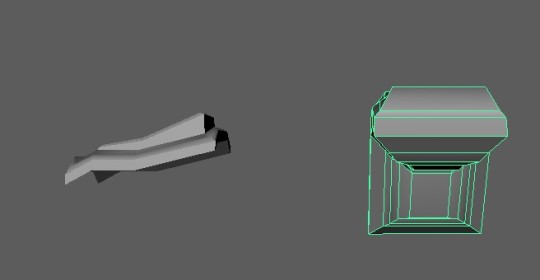

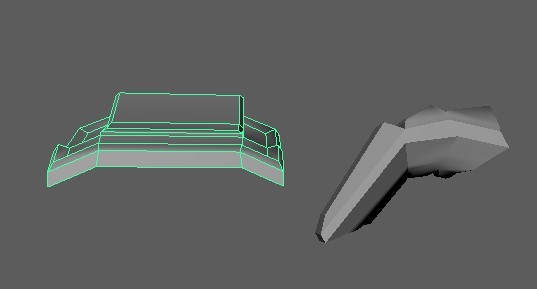
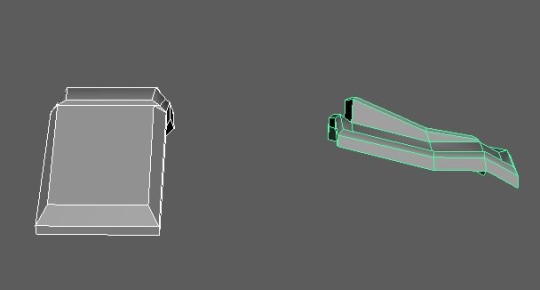
Gun
I also had this idea for a Quad Barrelled shotgun but didn't end up having enough time to finish. While I didn't end up using any of these designs it did help me get back into practicing 3D and dusting off my Maya skills.

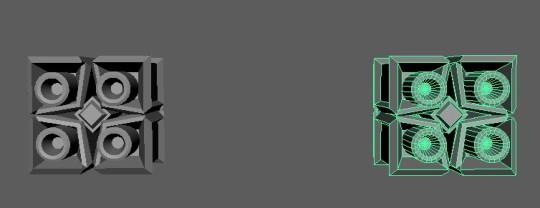

Characters
Since part of the appeal of the Arena Shooter is the vast and interesting skins to play as I really wanted to get the diversity of the future across.
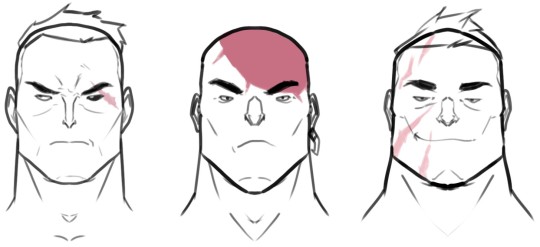



I set out to getting a lot of ideas blocked out for different looks that could represent different nations. For example the Imperium have designs inspired by classic medieval knights (B & I), the Tribes have bone and fur inspired outfits (A & F), the Bandits have mercenary and biker inspired outfits (C & J), Bio Mechanical armour types such as (K & L) attach and exist in harmony with the host, the Necris are undead cultists and wear all sorts of strange Gear (G & D), There are also Rebels (H & E) as well as robots (M & others not pictured until the final image, as I was running short on time). I wish I would have had more time to develope these characters further as some do feel a little half baked and generic in the final image.
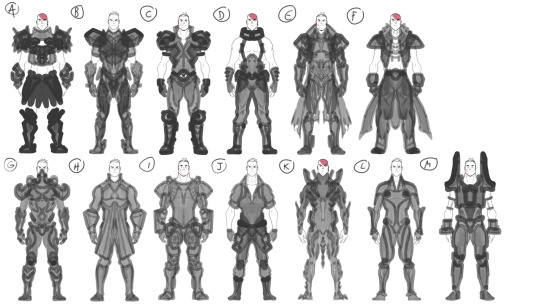
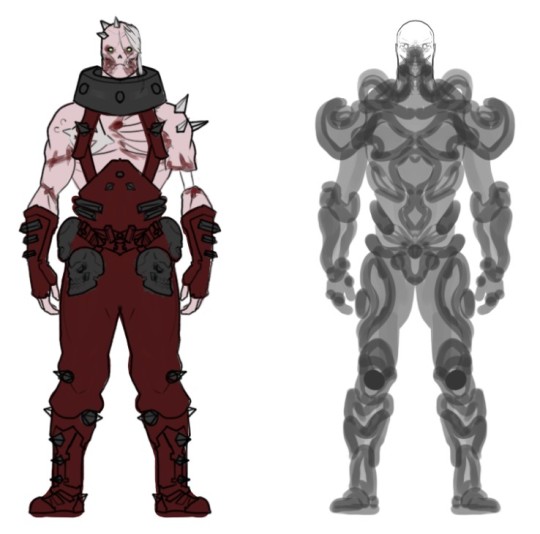
Composition
Initially my plan was to do two separate images for the coloured and the black & white submissions. The coloured one would be a piece of Key Art showing a 'Match in progress'. After getting feedback from my Tutor we agreed that an engaging image for the black and white would be gladiators entering the arena. So I put some basic compositions together, working as I went and cutting planning shorter than usual as I knew I had just about enough time for what I'd planned.
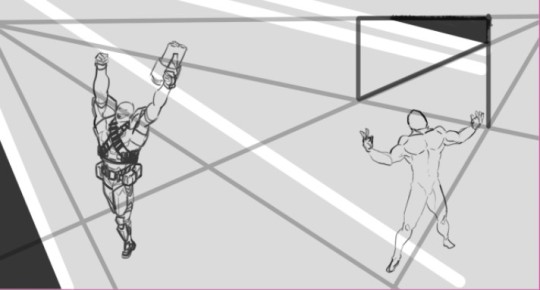

I then worked out how my characters would feature in the composition, adjusted it, added my light source and set to designing the characters as I filled them in.

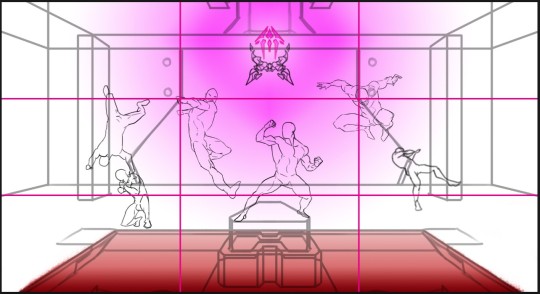
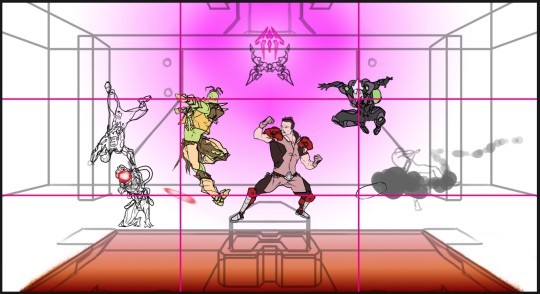
I wanted to add elements in the four intersections of the rule of thirds but also keep the eye drawn to the center. So I created this whacky sort of triangle/rule of thirds composition. I'd seen vertical, horizontal and diagonal compositions but never a specifically triangular one, so I was excited to see if I could pull it off. I used some gears in the foreground to 'cut off' the bottom sides of the image as there were lines leading the viewer's attention off-image so I wanted to hem them in.
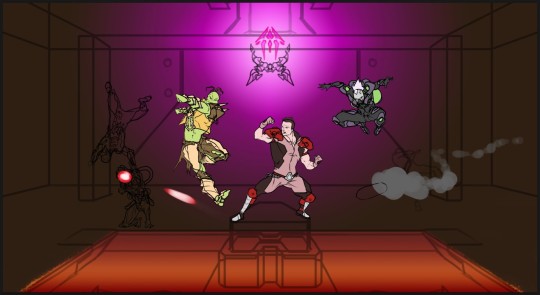
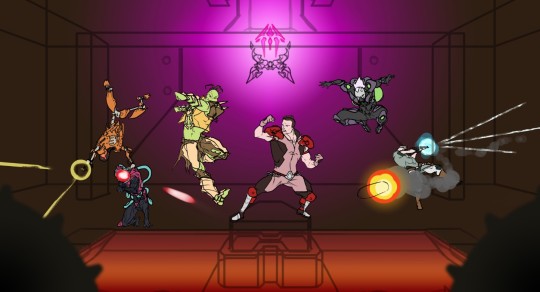
I tried and retried the lighting a few times, adding darker shadows here and there and changing the hue, as well as reworking the colour scheme of the background to a royal blue and gold which worked really well with the purple and orange lighting. I also added cinders in the foreground with varying degrees of gaussian blur to add some visual flair as well as fully designing the background in it's full edgy 90's Arena Shooter glory.

Finally I tweaked some lighting, added extra shadows, lightened the background for more depth and added some fiery haze behind the pyramid in the front to help the main subjects pop. I'm quite proud of the resulting composition although a day or two more of fine-tuning could have helped it really come together.


Final Pieces
As I had run out of time by this point I was unable to finish the second image and simply chose to flatten and convert this image to black and white but it actually makes the value shine even better than the colour image. Which I was not expecting.


All in all, I was very happy with how this project turned out.
#concept art#digital art#digital illustration#digital painting#digital drawing#artists on tumblr#arena shooter#quake#unreal tournament
4 notes
·
View notes
Text
I was explaining how my vision is like without my glasses on to my manager a couple days ago, and I tried to find a solid example that wasn't, like, not being able to read something, and I finally figured it out when I took them off and looked at him.
I can't tell if someone has freckles or not.
Like, unless they are two feet away from me, I cannot tell.
My manager has freckles/birthmarks on his face, so that was the easiest way to explain it, like, "Without my glasses on, you don't have freckles."
And I think that really got the point across, because it's a very distinct, like, feature of his, and I can't see that without my glasses on.
Basically, shadows on the face blend together, and there's, like, some color variation that's lost because of how my vision blurs/doubles.
I also, notably, have a harder time seeing in "warm" lighting.
Like, if you use the nightlight function on your phone or laptop, that yellow hue over the screen actually makes it harder for me to see details that, say, blue lighting!
I think it's largely because yellow lighting tends to be darker, whereas blue is brighter, but to give further examples of color combinations that are difficult for folks that are visually impaired like myself; Bright, light colors on white tend to be hard on my eyes/difficult to read.
Generally black text on a white background is better, but I, myself, do better with white text on a black background.
It helps me focus on the text, since it's highlighted and the background can kind of fade out to me.
But yeah.
This thought brought to you by me remembering I can't just buy and wear regular sunglasses even though they would be awesome to have and loads cheaper than having to get a prescription pair...
16 notes
·
View notes
Note
Hello! I am kinda new here and have been stalking your page for a little bit when I came across a post where you basically talked about how planning out stuff is very useful.
So my question now is how do you plan stuff and come up with ideas? What are your inspirations and such?
P.S. I love your writing and the way you stick to the character's real personalities <3
Hello! Aw, thank you for your kind words <33 I love your question & I had a lot to say on this subject, so I hope you don't mind a longer answer ᵔ ᵕ ᵔ
Overall, when it comes to planning, I think I'm quite an intuitive writer, so I like to tackle planning with a flexible approach. The key, for me, is staying organized and inspired.
Here's how I do it:
1. I daydream a lot & a lot of my ideas happen during my walks or when I can't sleep at 3am. To turn these thoughts into action, I keep a document on my phone where I dump everything that comes to mind, no matter how small (even if it's just word vomit, which most of the time it is, it's worth writing down. you never know what's going to be your next muse!)
2. Usually, before planning anything, I'll start by just writing (even if it's just a conversation between two characters). This may be a somewhat unorthodox approach, but I find that the act of just letting the words out and seeing how the idea shapes itself on paper helps me approach plotting. I'm able to see what works and what really doesn't.
3. From there, I'll actually start outlining my project. For longer projects, I plan chapter by chapter, scene by scene, in chronological order and using bullet points. I don't go into micro details (sometimes, it's literally just putting down "??? figure something out girl", without knowing what's going happen). Instead, I try to figure out the significance of the scene & how it drives the characters' journeys & plot forward.
-> I prefer this approach over overly rigid structures because planning for me is a continuous thing, where I discover more about the plot as I write and edit, and fill in blanks as I go. In this way, I find it important to be flexible with my outline and discover what feels right for my story (and sometimes, it really feels like certain characters are breathing down my neck, Eren style lmao).
-> Also, if you're a visual person like me, post-its and color coding are your friend! It helps me organize the chaos that is my brain.
On idea generation:
- I get my ideas just as much from within as from the world outside. Nature, music, and cinema are a big source of inspiration for me.
- Ideas that spark: books, video games, movies, music, Pinterest boards - I collect everything that inspires me (to the point where it might be concerning xD). I have over 40 playlists, including character-centric playlist like my Levi mixtape or my fanfics' playlists. I keep a blank page with quotes that inspire me, including things I’ve heard in real-life. I track the books that have inspired me and ask myself why they did. Basically, my motto is that the world is your garden, waiting to be filled with things that inspire you :D
- I like to ask myself “what-if” questions along the planning process, especially when I'm stuck. Example: "What if character A got hurt here? How would the cast react?". You can use writing prompts to guide you on this.
- Lastly, I also like to "interview" my characters. Trying to understand the characters helps to deepen my bond with them & it can be helpful to gather ideas. Here's an example of some questions, in case you're interested.
-
I hoped this answered your question! Wishing you the best of luck if you're working on a project, and thanks for stopping by!!
5 notes
·
View notes
Text
Bruh I've known for years that I have visual processing issues (separate from my actual vision problems) but I never really looked into the specifics of how it works before. I know sometimes, especially when my brain is tired, I have trouble making sense of shapes and separating the foreground of images from the background. So I can see the image perfectly fine but I can't make out what it is, even if it's something that should be very obvious like a singer crouching at the edge of a stage (actual example). Those moments are a lot like auditory processing issues, where you can technically hear what someone is saying just fine but your brain can't parse it into words. And when I'm having a lot of trouble with this sort of thing, image descriptions are helpful for me. I figured that was just what visual processing disorder was right?
Well now I'm reading more about it and it turns out that there are 8 different types of visual processing skills and VPD can affect any of them. The issues I just described would fall primarily under visual foreground issues bc it stems mainly from not being able to distinguish the foreground (singer) from the background (stage and audience). But it probably also involves some visual closure issues bc I have trouble figuring out what the full shape is if part of it is cut off (like if the singer is kneeling in such a way that not all of their limbs are fully visible), as well as form constancy issues bc I have trouble recognizing familiar shapes if they're in an unexpected position/context (singer kneeling close to the audience instead of standing on stage)
Reading more about form constancy has got me really mind blown actually. I have a lot of quirks that I always just attributed to autism/ADHD. I can't find objects in plain sight, for one thing, especially if they're in a different location than normal. I can set something down on a table right out in the open and almost immediately lose it if there's other objects nearby for it to "blend into." If I'm looking for something in a cabinet or the fridge or even just on a slightly crowded counter I have to ask my gf to remind me what color it is so I can just pick out the color, bc otherwise I can look forever and not find it. Even if I make a conscious effort to check each individual item, I can look right at it multiple times and still not process that it's the object I'm looking for. I have to make it a habit to always put things back in the exact same spot bc otherwise I can't see them. The other day I went to get a new roll of toilet paper from our toiletry shelf and I thought "damn, we're almost out, I better order some more." I didn't realize until I bought a new box and went to stack it on the shelf that there was already an entire new box right there, just slightly to the left. And this isn't even "tired brain" processing, this is my everyday normal
And apparently... that's all described as symptoms of form constancy issues? Like, some of the things optometrists warn parents to watch out for when determining if their child has VPD are "difficulty finding missing items quickly even if they are in plain sight" and "difficulty recognizing objects when placed in a new location"
Another issue I have is a ridiculous inability to orient myself, know my way around familiar places, or understand where I am in relation to other places. I still have to use GPS to get to shops near my home that I've been going to for years and I have no idea what direction anything is in. My gf and I once had some fun playing a game where we stood in our living room and she asked me to point in the directions of things like "the store across the street" and "the entrance to our apartment complex" and "the mailboxes" and "the dumpster by our building" and I was unable to get any of them correct. Part of it is bc even if I DO manage to memorize my way around somewhere it's just a single-line map telling me when to turn to get from point A to point B and it falls apart if I try to come at it from any other angle, and part of it is due to an inability to judge distances (I have taken the extreme long way around on multiple occasions bc I couldn't tell that "just around the corner of that side of the building" was a shorter distance than going around the opposite side of the building, circling around the back, and then coming in from the other direction)
...Turns out that another aspect of form constancy issues is "difficulty judging distances" and "difficulty picturing objects at different angles." Aaaand during this research I happened to stumble across a site with little baby games to help young kids with visual processing issues practice to improve their form constancy skills and uh. It's kinda kicking my ass 😭
I learned some FUN things about myself tonight lads
#prosopagnosia (faceblindness) also falls in the visual processing issues category apparently which. makes sense i guess?#im just kinda shocked that all these issues might be related tbh#like i had always thought of it as three separate things: faceblindness—spatial reasoning issues—visual processing issues#with the visual processing issues being the least impactful on my life bc it only really affected my ability to discern images#and usually only acted up significantly when my brain was particularly tired#but. apparently vpd is a much wider spectrum of issues than i even realized and it may be Causing the other issues? potentially??#idek what to do with this information tbh. it changes functionally nothing except that i can put a name to my experiences#ive already naturally worked out accomodations to make my life liveable with these challenges#like using my GPS everywhere and always putting items back in the same spot so i dont have to rely on sight to find them#and luckily i have a partner who is very patient and always willing to help me when i inevitably have trouble anyways lol#but this is definitely. some knowledge i guess#ill probably at least bring this up to my therapist but this may be outside of her wheelhouse 😅#rambling
5 notes
·
View notes